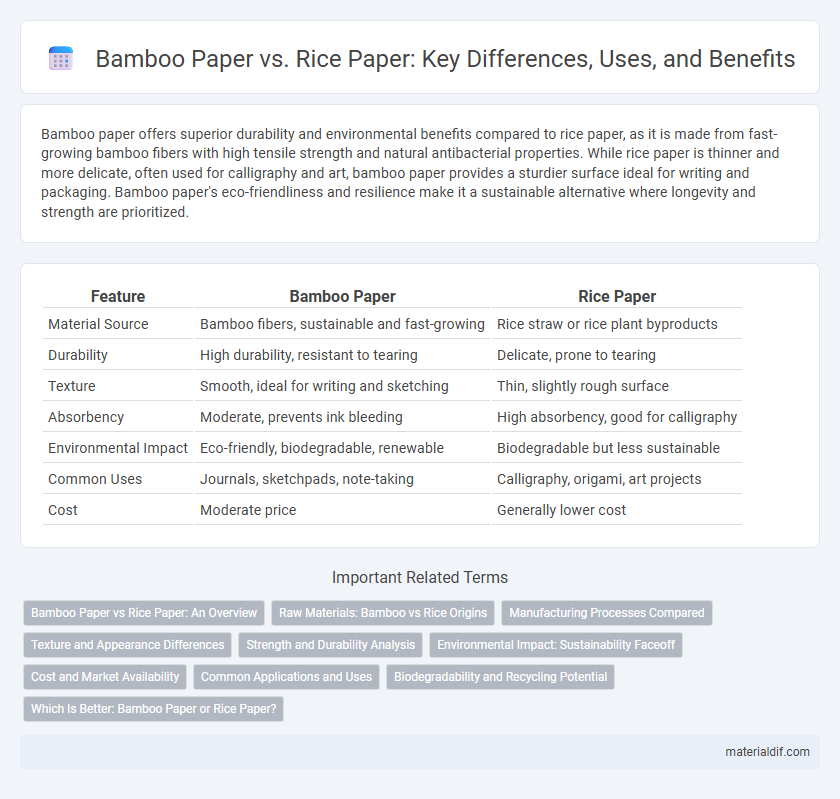Bamboo paper offers superior durability and environmental benefits compared to rice paper, as it is made from fast-growing bamboo fibers with high tensile strength and natural antibacterial properties. While rice paper is thinner and more delicate, often used for calligraphy and art, bamboo paper provides a sturdier surface ideal for writing and packaging. Bamboo paper's eco-friendliness and resilience make it a sustainable alternative where longevity and strength are prioritized.
Table of Comparison
| Feature | Bamboo Paper | Rice Paper |
|---|---|---|
| Material Source | Bamboo fibers, sustainable and fast-growing | Rice straw or rice plant byproducts |
| Durability | High durability, resistant to tearing | Delicate, prone to tearing |
| Texture | Smooth, ideal for writing and sketching | Thin, slightly rough surface |
| Absorbency | Moderate, prevents ink bleeding | High absorbency, good for calligraphy |
| Environmental Impact | Eco-friendly, biodegradable, renewable | Biodegradable but less sustainable |
| Common Uses | Journals, sketchpads, note-taking | Calligraphy, origami, art projects |
| Cost | Moderate price | Generally lower cost |
Bamboo Paper vs Rice Paper: An Overview
Bamboo paper is derived from bamboo pulp, offering a sustainable and eco-friendly alternative to traditional paper sources like rice paper, which is made from rice straw and other plant fibers. Bamboo paper is known for its durability, smooth texture, and resistance to tearing, making it suitable for printing and artistic applications, whereas rice paper is thinner and more delicate, often used in calligraphy and traditional art. The production of bamboo paper generally results in higher yield and faster growth cycles compared to rice paper, contributing to its growing popularity in green manufacturing.
Raw Materials: Bamboo vs Rice Origins
Bamboo paper is crafted from the fast-growing bamboo plant, valued for its sustainability and strength due to its high cellulose content. In contrast, rice paper originates from rice straw or pith of the rice plant, offering a delicate texture ideal for artistic and culinary uses. Both materials reflect their distinct agricultural origins, influencing the paper's durability, texture, and ecological impact.
Manufacturing Processes Compared
Bamboo paper is produced by mechanically processing bamboo fibers, including steaming and crushing, followed by pulping and drying, which results in a durable and eco-friendly material. Rice paper manufacturing involves soaking and boiling rice straw or pith, then spreading the pulp thinly on molds to dry, creating a delicate and translucent surface often used in art or culinary applications. The bamboo process emphasizes strength and sustainability, while rice paper focuses on thinness and flexibility through distinct fiber treatment methods.
Texture and Appearance Differences
Bamboo paper features a smooth, fine texture with a natural off-white color, offering a consistent surface ideal for writing and drawing. Rice paper has a more fibrous, delicate texture with a translucent, slightly rough appearance, often showcasing visible plant fibers that give it an organic, handmade feel. These differences in texture and appearance affect the paper's suitability for various artistic and craft applications.
Strength and Durability Analysis
Bamboo paper exhibits superior strength and durability compared to rice paper due to its dense fiber structure and natural lignin content, which enhances resistance to tearing and wear. Rice paper, while prized for its delicate texture and flexibility, lacks the tensile strength necessary for heavy-duty applications and is more prone to damage under stress. The fibrous composition of bamboo paper ensures longevity, making it ideal for archival purposes and crafts requiring robust material performance.
Environmental Impact: Sustainability Faceoff
Bamboo paper outperforms rice paper in environmental sustainability due to bamboo's rapid growth rate and minimal need for pesticides or fertilizers, making it a highly renewable resource. Rice paper production often involves higher water usage and chemical processing, increasing its ecological footprint. Choosing bamboo paper supports reduced deforestation and lower carbon emissions, positioning it as the greener alternative in sustainable paper options.
Cost and Market Availability
Bamboo paper generally offers a more cost-effective option due to the rapid growth and abundant supply of bamboo, making it widely available in the market. Rice paper tends to be more expensive, reflecting its labor-intensive production process and limited sourcing regions. Market availability favors bamboo paper, as it is produced at larger scales and distributed globally, while rice paper's niche demand restricts its accessibility.
Common Applications and Uses
Bamboo paper is commonly used for eco-friendly stationery, packaging, and art supplies due to its durability and sustainable sourcing, while rice paper is favored in traditional calligraphy, painting, and food wrapping because of its delicate texture and translucency. Bamboo paper's robustness makes it suitable for notebooks and printing, whereas rice paper's lightweight and absorbent qualities excel in culinary and artistic applications. Both materials highlight unique benefits in different industries, with bamboo paper promoting environmental sustainability and rice paper preserving cultural heritage.
Biodegradability and Recycling Potential
Bamboo paper offers superior biodegradability due to its natural fibers that break down quickly in composting environments, unlike rice paper which can take longer to decompose because of its denser composition. Bamboo paper's recycling potential is higher as it can be reprocessed multiple times without significant loss of fiber quality, whereas rice paper often has limited recyclability due to its fragility and mixed material content. Choosing bamboo paper supports sustainable waste management by enhancing recycling efficiency and reducing landfill accumulation.
Which Is Better: Bamboo Paper or Rice Paper?
Bamboo paper offers superior durability and eco-friendliness compared to rice paper due to its high fiber strength and sustainable sourcing. Rice paper, while traditionally used for art and calligraphy, tends to be more fragile and less resistant to moisture. For applications requiring longevity and environmental sustainability, bamboo paper is generally considered the better choice.
Bamboo Paper vs Rice Paper Infographic

 materialdif.com
materialdif.com